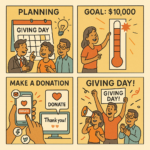Your First Giving Day: Lessons, Lead Time, and How to Get It Right

For many charities, hosting a Giving Day can feel like a leap into the unknown. It’s fast-paced, public, and—done right—transformative. But a successful Giving Day isn’t about luck; it’s about planning, coordination, and knowing what success looks like before you start.
Start Early: The Six-Month Rule
Charities that deliver outstanding Giving Days start planning at least six months in advance. Why? Because a Giving Day isn’t just a fundraising appeal—it’s a campaign, a communications event, and a culture moment rolled into one.
Six months out, you should already be:
- Securing board buy-in and leadership champions.
- Setting a clear, measurable goal (revenue, donors, recurring gifts, or new supporters).
- Identifying a match or challenge fund to build momentum.
- Developing a strong campaign theme or story that aligns with your mission.
This isn’t the time for vague goals like “raise awareness.” Define what success looks like in hard numbers and tie it directly to impact.
Three Months Out: Build the Engine for the Giving Day
Once your plan is framed, shift gears into campaign building:
- Develop your communications plan. Email, social media, SMS, website banners, and media outreach must all sing from the same hymn sheet.
- Segment your audience. Tailor your asks to different supporter groups: lapsed donors, regular givers, major donors, volunteers, and corporate partners.
- Line up ambassadors. Staff, board members, and volunteers should be ready to share personal reasons for giving and promote the day through their networks.
A Giving Day is as much about participation as donation—your success will hinge on your internal engagement as much as your external marketing.
One Month Out: Test Everything
In the final month:
- Run test donations through your platform.
- Check links, tracking, donation pages, and automations.
- Prepare your thank-you messages and social media content in advance.
- Ensure your back-end data team is ready to process gifts in real time.
It’s the nonprofit version of a dress rehearsal—no surprises allowed.
Giving Day Itself: Energy and Agility
On the day, momentum is everything. Post updates throughout the day, celebrate milestones loudly, and keep supporters informed. Highlight stories, staff, and donor quotes. Make it visible, emotional, and social.
Have your CRM, comms, and data teams on standby together—ideally in one room—so you can pivot if needed. If something goes wrong, fix it fast and move on. Transparency beats perfection.
After the Rush: Stewardship and Reflection
A Giving Day doesn’t end when midnight strikes. The 24 hours are just the spark—what you do next determines whether you retain those new supporters.
Within 48 hours, send personal thank-yous. Within two weeks, report on outcomes and impact. Then, evaluate:
- Did you meet or exceed your goals?
- Which channels performed best?
- Who were your most effective ambassadors?
- What would you do differently next time?
Document everything. The first Giving Day sets the tone and framework for future ones.
Lessons Learned from Others
Charities that have gone before often highlight three truths:
- It’s more work than you think. It’s a full campaign, not a one-day sprint.
- Your story matters. Generic appeals fail—specific, emotional storytelling wins.
- Momentum is gold. A matching gift, a live leaderboard, and strong internal engagement make the difference.
A Giving Day is your organisation’s chance to rally your community, test your systems, and build excitement around giving. Plan early, execute tightly, and steward well. Do that—and your first Giving Day won’t be your last.
